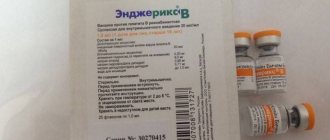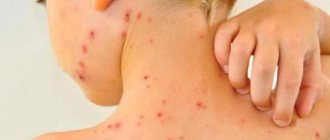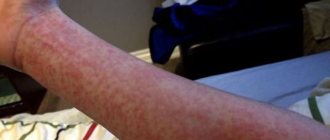Measles is a viral disease characterized by a number of unpleasant consequences and complications and enters the body through the respiratory tract, mucous membranes of the nose and mouth. Measles was described as a separate disease in the 17th century, but there is still no etiotropic treatment aimed at eliminating its cause. The doctor prescribes individual treatment for each patient, which can only alleviate the symptoms. But one of the features of the course of this disease is a very high degree of transmission from a patient to a healthy person, almost 100%. At the same time, at the initial stage, measles can occur with mild symptoms, and the incubation period in an adult lasts up to a month. But most often children of preschool and primary school age get measles.
The only way to prevent health damage today is measles vaccination. The first vaccinations were tested 300 years ago, but researchers are still working on new vaccines, creating an increasingly effective and long-lasting drug. Nina Yandraykina, a pediatrician at the MEDSI children's clinic on Pirogovskaya, talks about the characteristics of measles in children and which measles vaccination for children would be optimal in modern conditions .
Measles is a truly dangerous disease, and above all because in most cases it occurs with pronounced symptoms, which in themselves are painful for the child: if it is a temperature, then it is very high, up to 39–40 degrees, if it is a cough, then it is sharp, irritable, if conjunctivitis, then with swelling of the eyes and photophobia. General symptoms are also clearly expressed - severe weakness, loss of appetite, headache, and sometimes vomiting, delirium, and convulsions can even occur.
“Measles is also dangerous because, even without complications, it sharply reduces immunity. Researchers have proven that the measles virus leads to T-immunodeficiency, that is, to a deficiency of cells that create immunity. This state of “anergy” lasts about a month after the illness itself and can cause the development of other diseases,” says Nina Yandraykina.
Complications from measles are also not simple - they are pneumonia, otitis media, laryngitis, stomatitis, and severe encephalitis. Laryngitis can occur with measles croup. The impressive list of complications continues with hepatitis, pancreatitis, thrombocytopenic purpura (ITP, primary immune thrombocytopenia, Werlhof's disease - an autoimmune blood disease), hemorrhagic syndrome - skin hemorrhage, bleeding of the mucous membranes, pericarditis, myocarditis (damage to the heart muscle) and keratitis, which leads to blindness . Subacute sclerosing panencephalitis is considered an extremely severe complication. The prefix “pan” means “solid”, that is, it is a continuous inflammation of brain tissue - a disease leading to loss of vital functions and early death. And it occurs in children with measles under two years of age. As studies have shown, it was vaccination that contributed to a sharp decrease in the incidence of panencephalitis.
It is also important to know that there is no single antiviral drug against measles. Treatment of measles is nonspecific, it is aimed at eliminating individual symptoms.
The danger of measles also lies in its high contagiousness and high susceptibility. The disease is transmitted by airborne droplets; one person can infect 18 others in contact with him. The measles susceptibility index is 0.96. People who have not previously had measles and have had direct, even short-term contact with a sick person, almost all become ill, regardless of age.
How does measles occur in children and how do signs of the disease appear?
There are different degrees of the disease - mild, moderate and severe. However, in children, measles most often develops in moderate and severe forms, and is especially severe in children under two years of age. The mild form at the onset of the disease is quite dangerous, when the child has a slight fever, a slight cough, and can still attend kindergarten or school. If the disease is not tracked in time, such a child can infect all other unvaccinated children in the kindergarten or in the entire school (due to its high contagiousness).
The main symptoms of measles are fever, weakness, catarrh of the upper respiratory tract, inflammation of the eyes, and rash. The disease occurs cyclically. The first stage is catarrhal, when the main symptoms appear - cough, runny nose, fever, general weakness, conjunctivitis with photophobia and a “semolina”-type rash on the oral mucosa (the so-called Belsky-Filatov-Koplik spots), characteristic only of measles. Before the second stage begins, the temperature usually drops.
“After 3-4 days, the next stage begins - the period of rash. This is the peak of the disease, in which all the symptoms increase sharply, the temperature rises again and can reach 40 degrees or more, the cough intensifies, the lips and eyelids swell, the eyes water or fester, it hurts to look at the light, says Nina Yandraykina. “And a rash appears, starting from the area behind the ears and from the cheeks, then going down to the neck and chest, and the next day - to the entire torso, and on the third day also to the limbs. This stage lasts on average 3–4 days. Then comes the third stage - the period of pigmentation, when the rash gradually turns pale, disappears within 7-10 days, turning into light brown spots and accompanied by pityriasis-like peeling on the body, the temperature normalizes, and appetite appears.”
But, despite the improvement in the condition, the pigmentation phase is characterized by the presence of “anergy”, that is, a decrease in immunity. Therefore, those recovering from measles should be especially protected from contact with other infections and from physical and emotional stress.
Complications of measles
In 30% of cases, measles leads to complications. The most common complications occur in children under 5 years of age and people over 20 years of age.
The most common complications are pneumonia, otitis media and other bacterial infections, as well as blindness, hearing damage, and mental retardation . People with measles are especially susceptible to streptococcal infections .
In one case per 1000-2000 cases of measles, encephalitis (usually 2-21 days after the appearance of the rash), often starting with fever, seizures and coma.
One in a hundred thousand people who have had measles develops a severe chronic disease—subacute sclerosing panencephalitis (SSPE). It develops months and years after contracting measles, causing intellectual degradation , seizures, and movement disorders; The disease usually ends in death.
The disease is dangerous for pregnant women. If a pregnant woman gets measles, the probability of miscarriage and fetal abnormalities is about 20%.
The virulent effect of the virus is enhanced by poor socio-economic living conditions.
How long does the effect of the measles vaccine last?
“It is believed that the duration of immunity after vaccination is comparable to that during a natural infection, which means lifelong,” says Nina Yandraykina. “But such conclusions require further observations, since the mass use of measles vaccine began only in 1965–1968. There are other data. According to the researchers, depending on the strain of the virus used in the vaccine, the effect lasts on average from 12 to 18 years after the second vaccination. However, some authors provide data that even after 26–33 years, the effect of vaccination continues to operate, and a person has antibodies in protective concentrations.”
Measles mortality
Measles ranks first in the world in terms of mortality, and mortality is especially high in developing countries. The mortality rate from measles in industrialized countries is 1-2 per 1000 cases of the disease, and in developing countries it can reach 10%.
The measles virus (like many other viruses) prefers nervous tissue to reproduce. Viral meningoencephalitis (inflammation of the brain and meninges) is another sad “calling card” of measles. According to WHO estimates, every 15 seconds around the world, 1 child dies from measles encephalitis; more than 2 million children die every year. The mortality rate for brain damage reaches 40%. Other complications are stomatitis (inflammation of the oral mucosa), pneumonia (pneumonia).
The main cause of death from measles (1-3 per 1000 cases in developed countries) are complications such as pneumonia (inflammation of the bronchi and lungs), severe diarrhea (diarrhea), and malnutrition. Measles can lead to lifelong disability due to brain damage, as well as blindness (due to damage to the sclera and cornea) and deafness. Mortality from complications of measles (according to WHO, 1986)
| Complication | Frequency | Mortality |
| Diarrhea | 59% | 0,6% |
| Lung complications | 38% | 2,1% |
| Pneumonia | 6% | 5,1% |
Are there possible side effects of the measles vaccine for a child?
Reaction to a vaccine: can it bring unpleasant consequences? This is a question every loving parent asks. Nina Yandraykina agrees that the measles vaccine for children, like others, can have side effects:
“Most often, these are acceptable adverse reactions, when some children develop rashes, cough, runny nose or fever between the fifth and 20th day. But all these symptoms do not last long (2-4 days) and disappear on their own.”
The most unpleasant consequences of measles vaccination for children are high fever (especially dangerous for children prone to febrile convulsions) and allergic reactions to vaccine components, in particular to chicken or quail egg white. These unpleasant reactions can be avoided by observing contraindications to vaccination and taking antipyretic or antiallergic medications.
Possible body reactions to measles vaccine
Any immunobiological anti-measles drug, whether imported or domestically produced, contains weakened live viruses.
Therefore, the measles vaccine is weakly reactogenic and, as a rule, is not accompanied by any pathological manifestations. Most vaccinated children do not experience post-vaccination reactions.
Quite rare possible post-vaccination reactions can manifest themselves in the form of an increase in temperature no higher than 38 C or mild malaise for 2 or 3 days.
Babies prone to allergies may experience minor skin rashes on the 4th day after vaccination that last up to 2 weeks. The occurrence of serious complications is rare.
Who and where can get vaccinated?
As a rule, if the child is 12 months old, preference is given to the shoulder or hip; at six years of age, the injection is given to the shoulder or shoulder blade. Vaccination against measles is necessary for all susceptible children, that is, all children one year and older who have not had measles and have not been vaccinated previously.
Measles vaccination for children is included in the national vaccination calendar and can be done in any medical institution where there is a pediatrician and a vaccination office. Before the procedure, the child must be examined by a doctor, and all necessary information about the child is collected.
If a child has previously suffered a mild acute illness, for example, seasonal acute respiratory infections, then at least two weeks should pass before vaccination. If the baby has had bronchitis or pneumonia, then the vaccine is given no earlier than a month later.
Where do they put it?
Measles vaccine can be administered subcutaneously or intramuscularly . The route of administration depends on the specific vaccine. Vaccines currently in use such as:
- MMR II - administered subcutaneously,
- Ruvax - administered subcutaneously or intramuscularly,
- Priorix - administered subcutaneously or intramuscularly.
The exact method of administration must be inquired in advance from the pediatrician in order to prepare the child for the procedure.
On a note! Appropriate books and songs will help prepare your child for vaccination, for example How Pasha Got Measles and YouTube: Songs for Children - Immunization.
Recommendations from pediatric associations say the following:
- Distract and calm your baby by hugging, singing, or talking quietly to him.
- If conditions permit, the baby can be breastfed before and during vaccination. Breastfeeding is naturally expected during the administration of injectable vaccines rather than oral ones.
- Smile and look him in the eyes. Let the child know that everything is okay.
- Comfort your child with a favorite toy or book. A blanket that smells like home will help your baby feel more comfortable.
- Hold your baby firmly in your lap if he is already sitting confidently.
- Once your child has received all of his vaccinations, be especially patient. Hold him in your arms and hug him. A soothing voice combined with praise and hugs will help him understand that everything is okay.
- If the child has fainted before, it is better for him to lie down during vaccination.
- If your baby is given several vaccines at a time, the least painful one should be administered first.
Is it possible to get sick after vaccination?
Basically, although the vaccine contains live viruses, they are so weakened that they are not capable of causing a full-blown disease. Often, vaccination can cause some kind of measles in a very weak form; such reactions occur easily and go away on their own, a maximum of 18 days after the injection. A person in this state is not contagious to others.
However, sometimes a vaccine does not cause the formation of immunity against the disease, and a person can become fully ill with measles while being vaccinated. This phenomenon in medicine is called failure of vaccination immunity and can be observed in a small percentage of all people.
Measles incidence statistics in Russia and in the world
Is there a great danger of getting infected?
According to Rospotrebnadzor, in 2021, 2,538 cases of measles were recorded in Russia, of which 52% were in children under 14 years of age. Compared to 2017, there are 3.5 times more cases of measles.
Director of the Institute of Public Health, Head of the Department of Epidemiology and Evidence-Based Medicine of the First Moscow State Medical University named after. Sechenov Nikolay Briko:
“In 2021, one in a million people suffered from measles in Russia. But since 2017, the decline has given way to an upturn. In 2021, 2.4 thousand people were already infected with measles, and in 2021, judging by the latest data, the growth continued. There are many children among the sick. Mostly unvaccinated people or people with an “unclear vaccination history” become infected. Most cases are imported.
The same thing is happening in many countries of the world: in Europe, America, Africa. The number of deaths is growing. More than 84 thousand people died from measles in 2021, and 110 thousand in 2021.
Of course, fewer people die from measles now than before the vaccine. According to WHO, 82.5 thousand people fell ill in Europe in 2021. At the same time, there are 72 deaths.
The highest incidence rates are in Ukraine, Serbia, Greece and Georgia. Ukraine accounts for 54.5 thousand cases and 14 deaths, because vaccination coverage in Ukraine is only 54%.”
Which vaccine is better
Despite the completely different composition of domestic and imported vaccines, they all demonstrate high effectiveness in combating measles. There are 2 significant differences between these vaccinations. Firstly, domestic vaccines are prepared on the basis of quail eggs, while foreign analogues are made on the basis of chicken eggs. If you are allergic to any of these components, you should choose a different vaccine.
Secondly, imported vaccines have a multicomponent composition and protect against three infectious diseases at once - measles, mumps and rubella, which is very convenient in terms of vaccination. When choosing domestic vaccines, vaccinations will need to be done 2-3 times in each period of life. But at a local clinic you can only get a domestic vaccine for free, so you need to approach vaccination consciously, weighing the pros and cons.











